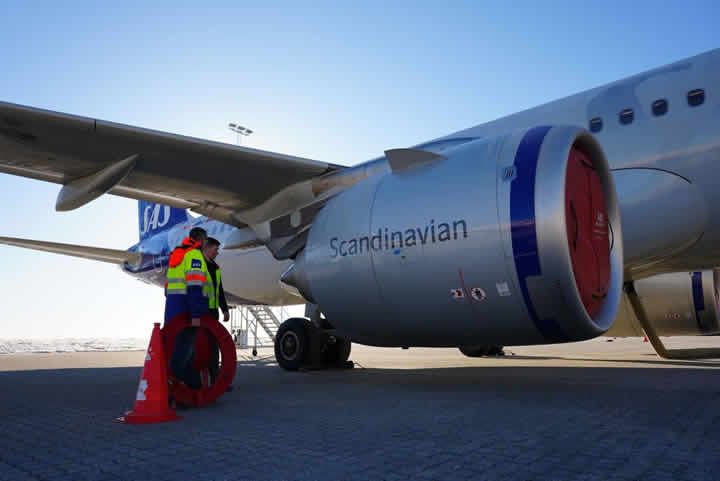How a specialized local engineering company supported a major airline during the pandemic with jet engine covers made with 3D printed molds.
 3D Printing Produces Engine Covers To Accelerate Aircraft Maintenance
3D Printing Produces Engine Covers To Accelerate Aircraft Maintenance

Case study from | BigRep
Airplanes Grounded During COVID-19
The world was brought to a sudden standstill in March 2020. The COVID-19 pandemic halted most travel, resulting in the immediate grounding of 62% of passenger planes. [1] Consequently, various challenges emerged, including a lack of parking real estate and increased maintenance costs for planes not designed to stay idle. Scandinavian Airlines (SAS), in particular, had most of its planes exposed to Norway’s typically harsh winter.
Grounding a fleet is not an easy task. When parked for long periods, airplane engines need protection from the elements as well as other detrimental influences like debris and animals. Airlines have a few choices, such as specialized long-term storage in a dry, warm climate or a more flight-ready approach. [2] The latter involves keeping the engines covered while parked outside, aside from required weekly engine operation checks.
Standard procedures require various covers to prevent moisture and other objects from damaging the engines, keeping humidity levels stable with desiccants. Unfortunately, airlines like SAS did not have the necessary inventory of off-the-shelf engine covers, exhaust plugs, etc., for these additional grounded planes. Without proper equipment, parking the airplanes wouldn’t have been an option.
Initially, as a remedial fix, SAS used plastic wrap and tape, an acceptable approach for small-scale, short-term storage. However, with continuously idle airplanes, the engines need to be uncovered for their weekly engine starts. Jason Deadman, a production engineer at SAS, describes the eight-hour process of engine unpacking and repacking for these checks as “quite an operation.”
As the pandemic extended, a longer-term solution that was quicker and more cost-effective was needed.

Supply Chain Interruptions
A simple solution to this lack of engine covers, of course, was just to order more. Yet, COVID-19 ignited a domino effect in global supply chains. Without access to raw material during lockdowns, manufacturing slowed down, and fewer products were being made. One survey found that only a fraction of supply-chain companies could operate without disruption. [3]
The timely sourcing of parts from usual suppliers was nearly impossible. This problem called for some creative thinking. Several companies began to work beyond the normal system, such as shifting to in-house manufacturing, chartering cargo vessels, and redesigning parts to use what was available. [4]
Specifically, airlines encountered limited ground-service equipment availability. As a result, SAS determined that shortening the supply chain was the key—harnessing more locally available resources. This option would not only solve their logistics challenges but also move SAS toward a more eco-friendly and less risky operation.

Thinking Outside the Box with 3D Printing
A shorter supply chain requires a search for local opportunities. Jason at SAS thought of 3D printing as a possible solution for their supply chain issues. After all, the benefits of 3D printing align with the company’s needs and values. These include fast production, design flexibility, low volume, low cost, and minimal waste. [5] Small objects could be produced easily with this technology, but how could he procure service equipment on an airplane scale? Despite the limitations in materials and size of most 3D printers, this seemed to be an untapped opportunity for the airline. SAS asked a local specialized supplier, CNE Engineering, how 3D printing can help with its grounded planes.
Nathan Brown, the founder of CNE Engineering, began reviewing the material requirements for the engine exhaust covers. They needed to withstand extreme outdoor temperatures and exhibit chemical and UV resistance. In addition, it needed to be soft yet robust—both the engine and cover could not be damaged when covered and uncovered. Based on these requirements, Nathan considered castable urethane, a widely available and low-cost material option.
This material, coupled with SAS’s volume needs of 20–100, called for cast parts. Fortunately, CNE revealed they could still 3Dprint the casting molds, or tools used to produce the equipment SAS needed. This option also met SAS’s timing requirements—initial equipment deliveries began several weeks after the project was initiated. By utilizing their BigRep large-format 3D printers CNE Engineering was able to act quickly, and produce custom tooling and equipment in-house at full scale to meet the immediate needs of SAS during the COVID Pandemic.

From Concept to Production
Now that the manufacturing approach was determined, the engineering details of the process followed. Once the casting production process was selected, CNE designed and engineered the molds, which utilized a combination of printed materials. This arrangement had to be liquid-tight, chemical resistant, and also allow for easy de-molding (part release). The BigRep ONE 3D printer could accommodate the top and bottom mold parts, in one piece, without needing to divide or segment them. BigRep’s STUDIO was used to produce mold parts that had smaller features and required a higher level of detail (e.g., negative space required for the cover’s handles).
The manufacturing process was refined as follows: The urethane tooling is printed and assembled, a process that takes a few days. Next, liquid urethane is poured into the mold to cure, taking only hours. In the end, one person can easily remove the final part from the mold in a few minutes.
SAS received its initial order within just two months of the kick-off meeting. Orders continued with similar quantities in various sizes for the different airplanes. The hours-long endeavor of wrapping and unwrapping jet engines is now a matter of minutes for a maintenance technician and these custom-built covers.
Where Can Large-Format 3D Printing Take Us?
CNE Engineering fulfilled three key aspects of their design with their BigRep 3D printers. First, a range of material options was available that enabled them to test and experiment with final-finish materials. Second, the build volume (1 m3) of the BigRep ONE was large enough to meet the dimensions of the jet engine exhaust with single-piece prints. Further, the print-line orientation of the mold design enabled the ease of casting and mold release.
Large-format 3D printing is an exciting innovative method of manufacturing solutions that demands unique parts or features, for example, complex curvature coupled with a flexible material.
Nathan at CNE sees endless opportunities for large-scale 3D printing. He hopes to expand designing and 3D printing tooling and equipment for other airlines with their ground-service needs as well as other industries. Nathan lists tool holders, carts, jigs, templates, and other hangar equipment as promising candidates for large-scale 3D printing. The aim is to simply “find customers and identify the need”.
Photo Credits: BigRep
The content & opinions in this article are the author’s and do not necessarily represent the views of ManufacturingTomorrow

BigRep
Founded in 2014, BigRep set sail to transform the 3D printing and manufacturing business. With its 1m3 volume, the BigRep ONE opens the gateway to a new dimension of 3D printing and 3D manufacturing, while the BigRep STUDIO allows fast and precise large-scale 3D printing. From furniture to vehicles to robotics, we think everything is possible. We want you to envision everything from human scale robot parts, sculptural artworks in all their full-dimensional glory, and dream the impossible world-changing designs of tomorrow while enabling you to print them today using one of our 3D printers.
Other Articles
How 3D Printing is Paving the Way for Grading Contractor, C.J. Moyna & Sons
3D Printing Powers Wind Turbine Research At TU Berlin
Winds Of Change For Vestas: 3D Printed Tooling Transforms Wind Turbines
More about BigRep
Comments (0)
This post does not have any comments. Be the first to leave a comment below.
Featured Product


